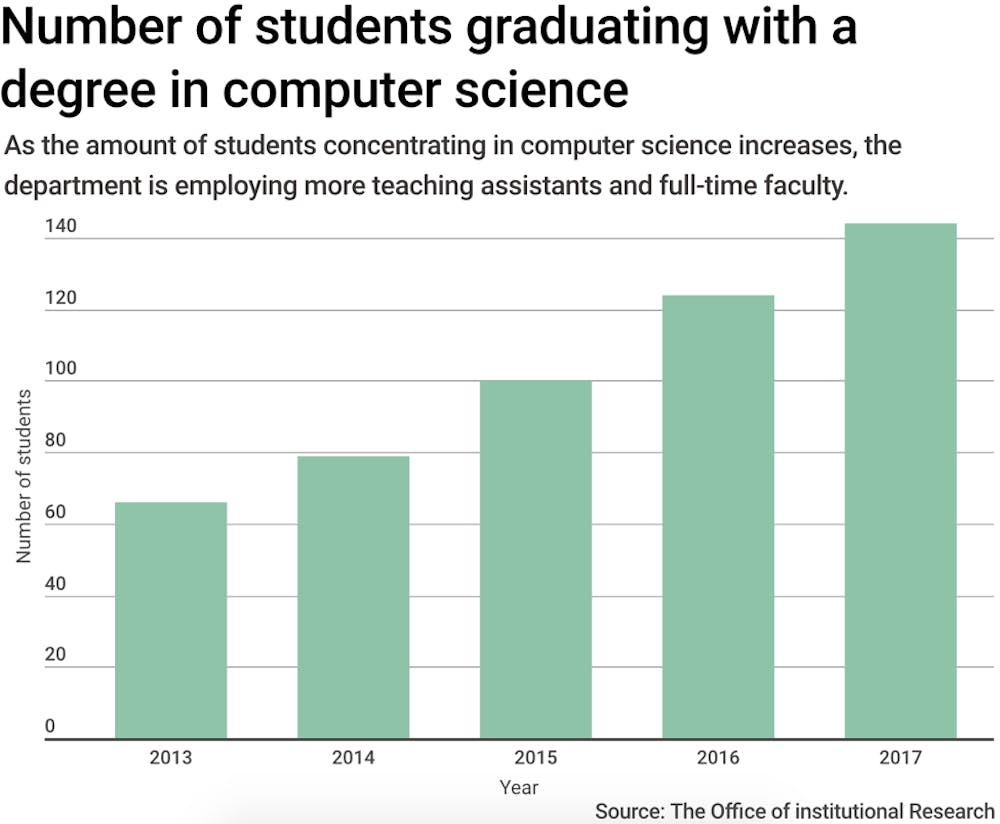As shopping period continues and students decide what they want to concentrate in, many are turning to the computer science department. Computer science is currently the most popular concentration at the University, as 440 students declared the concentration in spring 2017. The department also graduated 144 students in spring 2017, which meant that computer science surpassed economics as the department with the most graduates, according to the Office of Institutional Research’s website. The CS department first became the most popular declared concentration in fall 2016 after 321 students declared it as their intended concentration, said Jesse Polhemus, the computer science department’s communications and outreach specialist.
As a result of the growing number of students taking CS classes, the department has had to make some changes to accommodate everyone, including expanding class sizes and making previously capped courses uncapped, said Professor of Computer Science Shriram Krishnamurthi.
Even with larger class sizes, Brandon Chen ’19, a CS concentrator, still finds it easy to get help when needed.
“Classes are getting bigger, which is kind of disappointing,” Chen said. But “it’s definitely not a contributing factor to the accessibility of professors.”
“It’s a super collaborative department — people are really willing to help one another out,” said Heila Precel ’20, who intends to concentrate in computer science. “The T.A. programs, especially in introductory courses, are really emblematic of that.” Teachings assistants “are almost always holding hours and being available for students,” Precel said.
The department also created an endowment campaign for its undergraduate teaching assistant program in May 2015 to keep up with the costs of hiring more T.A.s for its growing classes, Polhemus said.
Over the years, the department has also recently grown in faculty size. Since 2012, the number of full-time faculty in the department ranged from 26 to 28. However, during the 2016-17 school year, the number reached 31 full-time members, Polhemus said. These additions not only increase the teacher-to-student ratio but also increase the topics covered by faculty, he added.
New faculty has “enabled the department to take on a much broader set of topics,” Krishnamurthi said. “As computing has grown, the department has slowly grown to sort of keep up.”
Students have become more and more interested in CS because the curriculum and skills are applicable to a wide variety of jobs, Krishnamurthi said. “People are realizing that essentially every company is now a computer company,” he said. Google, Microsoft and IBM are in the top five companies that employ Brown alums, The Herald previously reported.
In the past, “people saw computer science as this very linear progress where if you went into CS, you were going to become a programmer,” Polhemus said. “Nowadays, people realize that in just about any field there’s going to be a use for computing.”
Krishnamurthi does not anticipate this growth in interest to falter soon. “I think as the potential power of computing grows and the potential concerns about computing grow, there’s just going to be more and more demand and interest in it,” he said.
Despite all the changes the department has made, the rigor of the courses remains.
“No matter what our enrollment has been … we’ve always kept our courses rigorous,” Krishnamurthi said. “I think this is one of the reasons why outsiders like employers and grad(uate) schools really appreciate what we do because they view us as having really high standards, so that’s why students come out of here really well prepared.”





